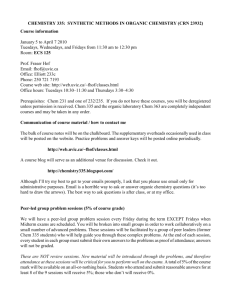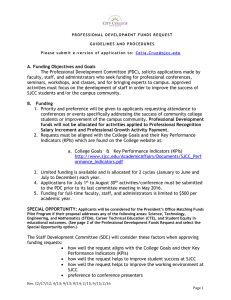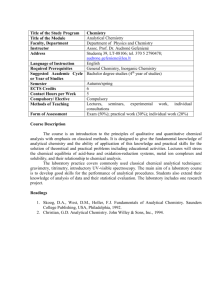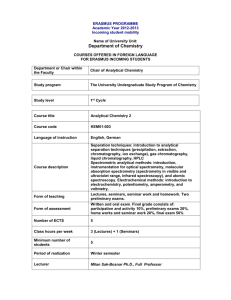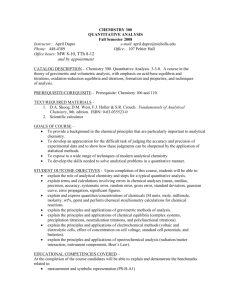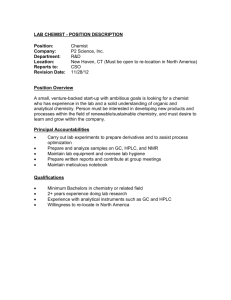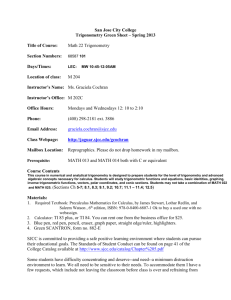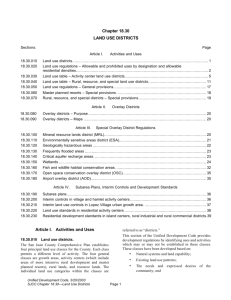Chem 65 course syllabus (Sum2013)
advertisement
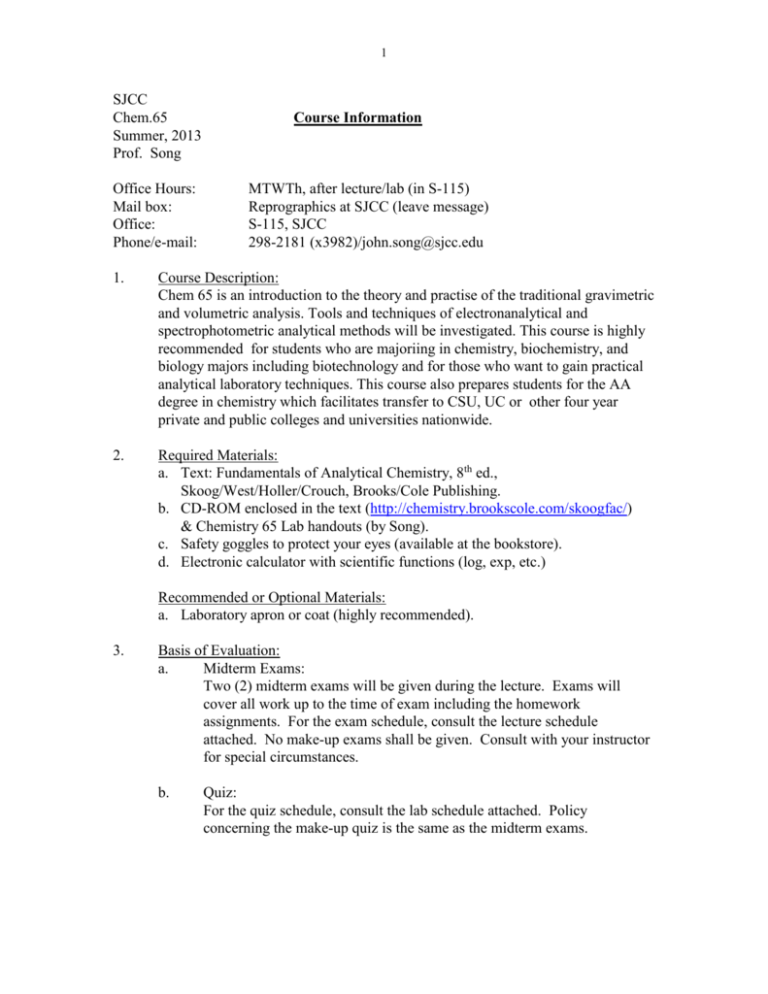
1 SJCC Chem.65 Summer, 2013 Prof. Song Office Hours: Mail box: Office: Phone/e-mail: Course Information MTWTh, after lecture/lab (in S-115) Reprographics at SJCC (leave message) S-115, SJCC 298-2181 (x3982)/john.song@sjcc.edu 1. Course Description: Chem 65 is an introduction to the theory and practise of the traditional gravimetric and volumetric analysis. Tools and techniques of electronanalytical and spectrophotometric analytical methods will be investigated. This course is highly recommended for students who are majoriing in chemistry, biochemistry, and biology majors including biotechnology and for those who want to gain practical analytical laboratory techniques. This course also prepares students for the AA degree in chemistry which facilitates transfer to CSU, UC or other four year private and public colleges and universities nationwide. 2. Required Materials: a. Text: Fundamentals of Analytical Chemistry, 8th ed., Skoog/West/Holler/Crouch, Brooks/Cole Publishing. b. CD-ROM enclosed in the text (http://chemistry.brookscole.com/skoogfac/) & Chemistry 65 Lab handouts (by Song). c. Safety goggles to protect your eyes (available at the bookstore). d. Electronic calculator with scientific functions (log, exp, etc.) Recommended or Optional Materials: a. Laboratory apron or coat (highly recommended). 3. Basis of Evaluation: a. Midterm Exams: Two (2) midterm exams will be given during the lecture. Exams will cover all work up to the time of exam including the homework assignments. For the exam schedule, consult the lecture schedule attached. No make-up exams shall be given. Consult with your instructor for special circumstances. b. Quiz: For the quiz schedule, consult the lab schedule attached. Policy concerning the make-up quiz is the same as the midterm exams. 2 4. c. Final Exam: A comprehensive final exam will be given. Students who miss the final exam without notifying the instructor will not receive grade higher than C for the course. d. Homework: Homework problems will be periodically collected and graded. Homework should appear neat and legible. It should be done on separate sheets (no torn out spiral notebook, please), stapled properly before turning in. No late homework is graded. Grading: The course grade earned will depend on the sum total of points earned in lecture and lab. The following weighting factors will be used. Hourly exams Final Exam Homework 30 % 20 6 Lab reports and conduct Attendance/ Participation 42% 2 Total = 100% The final course grade is based on the sum of individual student achievement in relation to minimum performance standard. The following table gives the approximate grade assignment* for the accumulated point total (lecture and lab). (*your instructor reserves the right to vary somewhat from the table based on the student performance in the class.) Accumulated point total (%) 90 - 100% 80 - 89 65 - 79 50 - 64 less than 50 Letter Grade A B C D F Attendance counts toward your grade. Coming to the class late often or attending part of the lecture or lab will be counted as absence. I will disqualify any student who miss the equivalent of one week’s lecture and lab without notifying me. This instructor deems academic honesty very highly. Thus, anyone suspected of cheating in the quiz or exam will not only lose credibility in my eyes but will also face the potential failure in the course. Please conduct accordingly to dispel any suspicion in the instructor’s mind. Best wishes for a successful summer in chemistry. Prof. Song 3 SJCC Chem.65 Summer, 2013 Instructor: Prof. Song Lecture Schedule (Text: Fundamentals of Analytical Chemistry, Skoog/West/Holler/Crouch, 8th ed., Brooks/Cole Publishing) Week of Topics to be covered in the text June 17 Introduction/Review of Elementary Concepts – Chapter 1, 4 Tools of Analytical Chemistry – Chapter 2, 3 Evaluation of Analytical Data - Chapter 5 - 8 24 Gravimetric Analysis - Chapter 12, 13 Chemical Equilibria- Chapter 9 - 11 Midterm Exam#1 - June 27 01 Holiday (Independence Day, July 04) Acid/Base Equilibria - Chapter 14 Acid/Base Titration - Chapter 15, 16 08 Complex Reactions and Titrations - Chapter 17 Intro to Electrochemistry- Chapter 18 Oxidation/Reduction Titrations – Chapter 19 - 20 Midterm Exam #2 - July 11 15 Potentiometry - Chapter 21 Bulk Electrolysis - Chapter 22 Intro to Spectrochemical Methods/Optical Spectrometry – Chapter 24 - 25 22 Molecular Absorption Spectrometry - Chapter 26 Intro to Analytical Separations/Gas Chromatography- Chapter 30 - 31 Review July Final Exam: July 25 4 SJCC Chem.65 Summer, 2013 Prof. Song Lab Schedule Week of June July Lab exercises scheduled (Source) (Page # refers to the lab manual written by Prof Song, available at SJCC bookstore) 17 Safety in the lab + check-in. Calibration of Volumetric Glassware (p4, lab manual) Gravimetric Determination of Chloride in a soluble Sample (p7-8, lab manual) 24 Determination of Chloride by Mohr Method (p10, lab manual) Determination of Chloride by Fajans Method (p12, lab manual) Determination of Chloride by Hg2+ Ion Titration (p13, lab manual) 01 Determination of Total Alkalinity of Soda Ash (p14, lab manual) Potentiometric Analysis of Phosphate Mixture (p19, lab manual) July 04 Holiday (Independence Day) 08 Potentiometric Titration of Chloride (p17, lab manual) Statistical Analysis of the Lab Data on Chloride Sample (p24, lab manual) Determination of Calcium by EDTA Titration (p36, lab manual) 15 Iodometric Determination of Copper (p26, lab manual) Electrogravimetric Analysis of Copper (p30, lab manual) HPLC Analysis of caffeine in drinks (Handout) 22 Analysis of Alcohol by Redox Titration of a Wine Sample (p31, lab manual) Lead content Analysis in Brass by Atomic Absorption (Handout) Checkout (July 25) Final Exam: July 25, 2010 5 SJCC Prof. Song Chem 65 Student Learning Outcomes Upon completion of this course, the student will be able to: 1. Evaluate and represent laboratory data using statistical analysis in terms of accuracy and precision. 2. Analyze chemical samples according to the theory of gravimetric and volumetric analysis; perform various volumetric titrations such as acid-base, complexometric, and redox using the appropriate glassware and instruments. 3. Explain the principles of electrochemical cells, both voltaic and electrolytic, and apply Nernst equation to practical laboratory experiments. 4. Describe the principle of spectroscopy and use spectrometers such as FTIR and UVVisible instruments to perform spectroscopic measurements. 5. Demonstrate the principles of separation techniques and use equipment to perform separation experiments such as Gas-Liquid Chromatography and HPLC.

